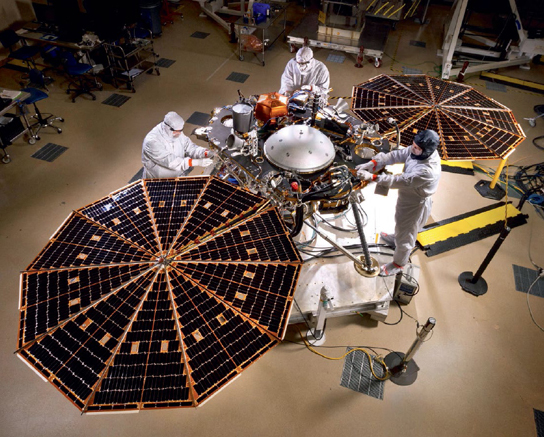2018
InSight to Mars
Enormous volcanoes and giant canyons attest to the fact that Mars has had a rich and diverse geologic history, especially early in its planetary development. But is Mars still active today? Is there still significant internal heat there? Are there Marsquakes? To address these kinds of questions, NASA will send a new lander to Mars in 2018, called the “Interior Exploration using Seismic Investigations, Geodesy and Heat Transport,” or InSight mission. The lander reuses much of the technology from NASA’s Phoenix mission, which successfully landed on and explored a region in the high northern polar latitudes of Mars in 2008.
InSight will carry a set of scientific instruments focused mostly on understanding the geophysics of the Martian interior. This includes a sensitive seismometer designed to make the first detailed search for and characterization of seismic waves on Mars (seismometers on the Viking landers back in the 1970s did not function properly after landing), whether from Marsquakes or from the relatively frequent small impacts of asteroids and comets. Other instruments include a heat flow probe to determine if there is still significant internal heat inside the planet, a radio tracking experiment to provide details on the Martian core, a meteorology station to help understand the current weather, and cameras to characterize the geology of the surroundings. The lander will be sent to an equatorial region not far from the large volcano Elysium, where it will hopefully be able to be in good contact with solid bedrock, and thus have maximum sensitivity to seismic waves.

Artist’s rendering of the InSight lander after deploying the seismometer and heat flow experiments.
InSight will be accompanied to Mars by a mission called Mars Cube One, consisting of two CubeSats known as MarCO-A and MarCO-B, designed to be the first demonstration of deep-space CubeSat technologies. The MarCO satellites will relay communications from InSight back to Earth in real time as the lander descends to Mars, and then they will continue beyond Mars to demonstrate the limits of interplanetary small-satellite telecommunications technologies.
SEE ALSO Mars (c. 4.5 Billion BCE), Vikings on Mars (1976), First Rover on Mars (1997), Spirit and Opportunity on Mars (2004), Mars Science Laboratory Curiosity Rover (2012).
Technicians work on the final testing of the NASA InSight lander before shipping it to Cape Canaveral, Florida, for a 2018 launch to Mars.
